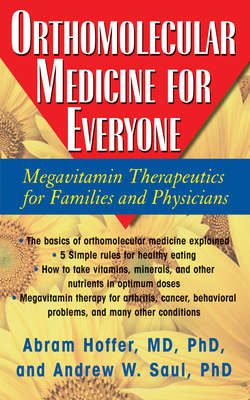Читать книгу Orthomolecular Medicine for Everyone - Abram Hoffer M.D. Ph.D. - Страница 42
SAFETY AND TOXICITY OF NUTRITIONAL SUPPLEMENTS
ОглавлениеWith any discussion of a substance as potentially toxic, one must clearly define what is meant by toxic. Potentially toxic is very different from toxic. Moreover, toxic is very different from death. The choice to use the word toxic may serve to convey a false impression of immediate and mortal danger. There are numerous symptomatic warnings before serious toxic effects occur. The most common is nausea, making the dose self-limiting. This is why the American Association of Poison Control Centers has reported that, in the United States, there is not even one death per year from vitamins.
Food supplements, including amino acids, herbs, vitamins, and minerals, have an extraordinarily safe usage history. Over half of the U.S. population takes daily vitamin supplements. Even if each of those people took only a single tablet per day, that makes 150 million individual doses per day, for a total of over 53 billion doses annually. Since many persons take additional vitamins, the numbers are considerably higher, and the safety of vitamins all the more remarkable. The number one side effect of vitamins is failure to take enough of them. Vitamins are extraordinarily safe substances.
In twenty-three years, vitamins have been connected with the deaths of a total of ten people in the United States. Poison control statistics confirm that more Americans die each year from eating soap than from taking vitamins. The most elementary of forensic arguments is, “Where are the bodies?” A review of U.S. poison control center annual reports tells a remarkable and largely ignored story—vitamins are extraordinarily safe (see the chart on page 57).
The zeros are not due to a lack of reporting. The American Association of Poison Control Centers (AAPCC), which maintains the national database of information from sixty-one poison control centers, has noted that vitamins are among the sixteen most reported substances. Even including intentional and accidental misuse, the number of alleged vitamin fatalities is strikingly low, averaging less than one death per year for more than two decades. In sixteen of those twenty-three years, there was not a single death due to vitamins.15 This is a product safety record without equal. These statistics specifically include vitamin A, niacin (B3), pyridoxine (B6), other B-complex vitamins, C, D, E, other vitamins such as vitamin K, and multiple vitamins without iron.
Minerals, which are chemically and nutritionally different from vitamins, have an excellent safety record as well, but not quite as good as vitamins. On average, one or two fatalities per year are typically attributed to iron poisoning from gross overdosing on supplemental iron. Deaths attributed to other supplemental minerals are very rare. Even iron, although not as safe as vitamins, accounts for fewer deaths than do laundry and dishwashing detergents.
Pharmaceutical drugs, on the other hand, caused over 2,000 deaths reported to poison control in just one year. These include antibiotics (thirteen deaths), antidepressants (274 deaths), antihistamines (64 deaths), and cardiovascular drugs (162 deaths). It would be incorrect to state that only prescription drugs kill people. In 2003, there were fifty-nine deaths from aspirin alone. That is a death rate thirty times higher than that of iron supplements. Furthermore, there were still more deaths from aspirin in combination with other products. Recent estimates indicate that there are at least 106,000 hospital deaths from pharmaceutical drugs each year in the United States, even when taken as prescribed.16
Fatalities are by no means limited to drug products. In 2003, there was a death from “cream/lotion/makeup,” a death from “granular laundry detergent,” one death from “gun bluing” (a process that protects gun from rust), a death from plain soap, one death from baking soda, and a death from table salt. Other deaths reported by AAPCC included: aerosol air fresheners (two deaths), nail polish remover (two deaths), perfume/ cologne/aftershave (two deaths), charcoal (three deaths), and dishwashing detergent (three deaths).
In America in 2003, there were twenty-eight deaths from heroin, and yet acetaminophen (such as Tylenol) alone killed 147. Though acetaminophen killed over five times as many, few would say that we should make this over-the-counter pain reliever a prescription drug. Even caffeine killed two people in 2003, a number equal to the two fatalities attributed to noniron vitamin/mineral supplements. Tea, coffee, and cola soft drinks are not sold with restriction, prescription, or in childproof bottles, and rather few would maintain that they need to be.
It is rare that a vitamin will negatively interact with a medication. On the other hand, it is common for a medication to create an actual vitamin deficiency. To find out, check in the Physicians’ Desk Reference (PDR), which is freely available at any library. Read up on your medication, paying special attention to any drug-nutrient interactions. Base your decision on facts, not a person’s opinion or belief.
Do not be buffaloed and do not be bullied. If someone tries to scare you from taking vitamins, ask to see the scientific papers that he or she bases such a warning on. Assuming that the vitamin critic actually respects you enough to honor your request and produce such documents, be alert to advertiser-driven bias in scientific studies.
